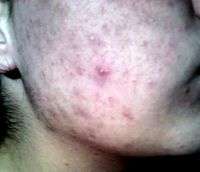Pimple
| Pimples | |
|---|---|
|
Blackheads, sebum darkened by contact and reaction with air. | |
| Classification and external resources | |
| Specialty | Dermatology |
| ICD-10 | R23.8 |
| ICD-9-CM | 709.8 |
A pimple, zit or spot is a kind of comedo and one of the many results of excess oil getting trapped in the pores. Some of the varieties are pustules or papules.[1] Pimples can be treated by various acne medications prescribed by a physician, or purchased at a pharmacy with a wide variety of treatments.
Causes
Inside the pore are sebaceous glands which produce sebum. When the outer layers of skin shed (as they do continuously), the dead skin cells left behind may become 'glued' together by the sebum. This causes a blockage in the pore, especially when the skin becomes thicker at puberty.[2] The sebaceous glands produce more sebum which builds up behind the blockage, and this sebum harbours various bacteria including the species Propionibacterium acnes, causing infection and inflammation.
-

A pustule.
-

Some more severe pimples can lead to significant swelling and may appear on the back and chest.
Treatment
Over-the-counter medications
Common over-the-counter medications for pimples are benzoyl peroxide and/or salicylic acid and antibacterial agents such as triclosan. Both medications can be found in many creams and gels used to treat acne (acne vulgaris) through topical application. Both medications help skin slough off more easily, which helps to remove bacteria faster. Before applying them the patient needs to wash his or her face with warm water and dry. A cleanser may also be used for that purpose. Acne rosacea is not caused by bacterial infection. It is commonly treated with tretinoin. A regimen of keeping the affected skin area clean plus the regular application of these topical medications is usually enough to keep acne under control, if not at bay altogether. The most common product is a topical treatment of benzoyl peroxide, which has minimal risk apart from minor skin irritation that may present similar as a mild allergy.[3] Recently nicotinamide, applied topically, has been shown to be more effective in treatment of pimples than antibiotics such as clindamycin.[4] Nicotinamide (vitamin B3) is not an antibiotic and has no side-effects typically associated with antibiotics. It has the added advantage of reducing skin hyperpigmentation which results in pimple scars.[5]
Prescription medication
Severe acne usually indicates the necessity of prescription medication to treat the pimples. Prescription medications used to treat acne and pimples include isotretinoin, which is a retinoid. Historically, antibiotics such as tetracyclines and erythromycin were prescribed. While they were more effective than topical applications of benzoyl peroxide, the bacteria eventually grew resistant to the antibiotics and the treatments became less and less effective. Also, antibiotics had more side effects than topical applications, such as stomach cramps and severe discoloration of teeth. Common antibiotics prescribed by dermatologists include doxycycline and minocycline.[6] For more severe cases of acne dermatologists might recommend accutane, a retinoid that is the most potent of acne treatments. However, accutane can cause various side effects including vomiting, diarrhea, and birth defects if taken during pregnancy.
Hygiene
Practicing good hygiene, including regularly washing skin areas with neutral cleansers, can reduce the amount of dead skin cells and other external contaminants on the skin that can contribute to the development of pimples.[7] However, it is not always possible to completely prevent pimples, even with good hygiene practices.
References
- ↑ "pimple" at Dorland's Medical Dictionary
- ↑ Anderson, Laurence. 2006. Looking Good, the Australian guide to skin care, cosmetic medicine and cosmetic surgery. AMPCo. Sydney. ISBN 0-85557-044-X.
- ↑ "Understanding Benzoyl Peroxide".
- ↑ Siegle, R. J.; Fekety, R.; Sarbone, P. D.; Finch, R. N.; Deery, H. G.; Voorhees, J. J. (1986). "Effects of topical clindamycin on intestinal microflora in patients with acne". Journal of the American Academy of Dermatology. 15 (2): 180–185. doi:10.1016/S0190-9622(86)70153-9. PMID 2943760.
- ↑ Handfield-Jones, S.; Jones, S.; Peachey, R. (1988). "High dose nicotinamide in the treatment of necrobiosis lipoidica". British Journal of Dermatology. 118 (5): 693–696. doi:10.1111/j.1365-2133.1988.tb02572.x. PMID 2969260.
- ↑ Morrison, A.; O'Loughlin, S.; Powell, F. C. (2001). "Suspected skin malignancy: A comparison of diagnoses of family practitioners and dermatologists in 493 patients". International Journal of Dermatology. 40 (2): 104–107. doi:10.1046/j.1365-4362.2001.01159.x. PMID 11328390.
- ↑ Barrymore, John. "Body Acne and Hygiene". How to Get Rid of Body Acne. Retrieved 18 August 2012.
External links
 The dictionary definition of pimple at Wiktionary
The dictionary definition of pimple at Wiktionary